Middle East Ceasefire: Iran and Israel Halt Hostilities Amid Global Concern

Breaking Development: Iran and Israel Agree to Ceasefire After 12 Days of Conflict
On June 24, 2025, former U.S. President Donald Trump announced a surprising breakthrough: a “complete and total” ceasefire agreement between Iran and Israel after nearly two weeks of high-stakes military confrontation. While the world reacted with cautious optimism, no official confirmation had yet been issued by Tehran or Jerusalem, and scattered attacks persisted on the ground.
Conflict Timeline: From Escalation to De-Escalation
| Date | Key Event |
|---|---|
| Jun 13 | Israel launches Operation Rising Lion, targeting Iranian nuclear sites. |
| Jun 13 | Iran responds with over 150 ballistic missiles and 100 drones. |
| Jun 19 | Missile strikes near Soroka Hospital in Be’er Sheva. |
| Jun 23 | Iran attacks U.S. Al-Udeid Air Base in Qatar; no casualties reported. |
| Jun 24 | Trump announces phased ceasefire mediated by Qatar. |
Ceasefire Details: What’s Included in the Agreement?
-
Phased Implementation: Iran halts operations first; Israel follows 6 hours later.
-
Initial 12-Hour Pause: Designed to transition into permanent cessation.
-
Mediated by Qatar: Key back-channel communication managed through Doha.
-
No Formal Declarations Yet: Both nations have yet to officially confirm or deny.
Ongoing Tensions: Is Peace Truly at Hand?
-
Fighting continues despite Trump’s declaration, with missiles exchanged even after the ceasefire timeline.
-
Iran signals willingness to pause, provided Israel reciprocates.
-
Israeli leadership silent, continuing to evaluate national security threats.
-
No UN oversight yet—monitoring and compliance remain undefined.
Why This Ceasefire Matters
-
Prevention of wider war: Avoids further escalation involving nuclear facilities.
-
Introduction of hybrid warfare: Use of covert drone strikes raises strategic concerns.
-
Crisis diplomacy tested: Qatar’s role highlights a shift in regional power brokering.
-
Humanitarian relief needed: Hospital strikes and civilian displacement underscore the human cost.
What to Expect Next
Diplomatic Developments
-
Iran and Israel may issue formal statements clarifying their stances.
-
UN and IAEA involvement could become necessary if nuclear facilities were hit.
Military Posture
-
Expect high alert in northern Israel and southern Iran.
-
Retaliation threats still linger from hardline factions in both countries.
Global and Regional Responses
Mediation Recognition
-
Qatar praised for swift coordination and its neutrality in the conflict.
Mixed International Sentiment
-
Western diplomats cautiously welcomed the ceasefire.
-
NGOs called for humanitarian access, especially in Tehran and Be’er Sheva.
Ceasefire Summary
| Aspect | Details |
|---|---|
| Announced By | Donald Trump (via Truth Social) |
| Start Time | Iran stops first; Israel after 6 hours |
| Mediator | Qatar |
| Military Status | Sporadic skirmishes still observed |
| Humanitarian Risk | Displacement, hospital strikes, and lack of access to aid |
Quick Facts – List Overview
-
Conflict lasted 12 days.
-
Ceasefire brokered by Qatar, not the U.N. or NATO.
-
Mossad drone strikes played a key role in Iran’s response delays.
-
Civilians targeted in Soroka Hospital missile strike.
-
Ceasefire may be temporary, pending government confirmations.
Conclusion: A Pause or a Path to Peace?
The Iran–Israel ceasefire, although welcome, is fragile and fluid. As diplomats, mediators, and military leaders navigate this moment, the world watches closely. Whether this agreement leads to lasting peace or a brief pause will depend on verified compliance, open communication, and genuine commitment from both sides.





























